Circular 662
Louis C. Bender
College of Agricultural, Consumer and Environmental Sciences, New Mexico State University
Author: Senior Research Scientist (Natural Resources), Department of Extension Animal Sciences and Natural Resources, New Mexico State University. (Print Friendly PDF)
Introduction
Arid and semiarid regions in New Mexico have historically supported large populations of mule deer (Odocoileus hemionus) of high ecological, recreational, and economic importance (Stewart, 1967). Current populations are only a fraction of historical numbers (Bender et al., 2012); consequently, much recent work has focused on habitat requirements of mule deer in arid regions of New Mexico. The guidelines in this circular have been developed from these recent studies in (1) the arid grasslands and woodlands of New Mexico State University’s Corona Range and Livestock Research Center (Bender et al., 2008, 2011), (2) the arid Chihuahuan desert and mountain habitats of the greater San Andres Mountains (Hoenes, 2008; Bender, 2010; Bender et al., 2012; Hoenes and Bender, 2012), and (3) the semiarid grasslands, shrublands, and woodlands of north-central and north-east New Mexico (Bender et al., 2007a, 2007b; Lomas and Bender, 2007). Information used to develop these guidelines includes commonalities in mule deer habitat use, movement patterns with respect to cover and foraging habitats, and responses of mule deer body condition, survival, and productivity to the habitat types, environmental conditions, and management treatments present in these study areas.
Mule Deer Habitat in New Mexico
Mule deer populations have declined to a fraction of their former numbers throughout much of New Mexico (Bender et al., 2007a, 2012), mostly because of declines in the quantity and quality of food, seasonal drought (particularly during the conception-parturition period, approximately January–June; Bender et al., 2007b, 2008, 2010, 2011, 2012; Hoenes, 2008), and, in some areas, decreased cover. Body condition of deer indicated that survival and performance of deer populations in all New Mexico study areas were limited by poor habitat quantity and quality (Bender and Rosas-Rosas, 2016; Bender and Hoenes, 2017, 2018; Caltrider and Bender, 2018). Consequently, the leading cause of mortality among all study area populations was malnutrition (Bender et al., 2007a, 2008, 2011, 2012; Lomas and Bender, 2007; Hoenes, 2008; Bender, 2010; Bender and Rosas-Rosas, 2016). During drought years, conditions in arid New Mexico can be so severe as to cause annual declines in population size of more than 35% (Bender et al., 2007a, 2011).
Drought primarily affects forb availability and timing of green-up in arid environments (Hoenes and Bender, 2012; Caltrider and Bender, 2018), and the strong effect of drought on reducing condition and productivity of mule deer was therefore likely related to a lack of forb production and availability of other actively growing forage during the late winter and spring of dry years. Impacts of seasonal drought thus tend to be much more severe in areas where mule deer depend on forbs and other herbaceous forages (Bender et al., 2007a, 2007b, 2008; Hoenes and Bender, 2012) as compared to areas where browse is more abundant (Hoenes, 2008; Bender, 2010; Bender et al., 2008). This effect is magnified because of the general decline in cool-season grasses throughout New Mexico (Bender, 2020). While seasonal drought will always decrease productivity of mule deer populations (Hoenes, 2008; Bender et al., 2008, 2011; Bender and Hoenes, 2017, 2018; Caltrider and Bender, 2018), survival of adults can be maintained at relatively high levels by managing for more drought-tolerant foods such as browse and reestablishing cool-season herbaceous species (Bender et al., 2008, 2010b; Bender, 2010, 2020; Hoenes and Bender, 2012).
Findings also indicated that piñon-juniper habitats were of key management importance for mule deer in arid habitats (Bender, 2020). The proportion of piñon-juniper in both annual and spring-summer-autumn (SSA) home ranges was generally negatively related to condition of mule deer, although lactating and dry females were differentially affected. Piñon-juniper cover had a negative effect on body fat accrual of lactating females, but no effect on dry females. Condition of deer, in turn, influenced all survival and productivity parameters of deer in all areas (Bender et al., 2007a, 2007b, 2008, 2011, 2012; Lomas and Bender, 2007; Hoenes, 2008; Bender, 2010; Hoenes and Bender, 2012, 2017, 2018). Further, deer preferentially used piñon-juniper on all areas, and piñon-juniper was associated with decreased sizes of deer home ranges (an indication of better habitat quality), likely because of its importance as security cover (Hoenes, 2008; Bender, 2010, 2020; Bender et al., 2008). For example, more than 88% of locations of mule deer were less than 660 ft from unmanaged piñon-juniper woodlands or savannahs on the Corona Range and Livestock Research Center (CRLRC).
Consequently, most immediate gains in mule deer habitat could be attained by managing piñon-juniper communities to increase forage quantity and quality, but care must be taken to preserve adequate amounts of cover for mule deer (Bender et al., 2007b, 2008, 2011; Hoenes, 2008; Bender, 2010, 2020; Hoenes and Bender, 2012) (Figure 1). The need to maintain piñon-juniper as deer cover is greater in areas where there is little topographic relief, such as areas similar to the CRLRC.

Figure 1. Benefits of well-planned habitat management include optimal mixes of forage and cover for mule deer, as seen here on the Canon Bonito Ranch in northeastern New Mexico. Such ranches produce high-quality mule deer and elk, which contribute significantly to the bottom line of ranches. Consequently, more rural land is maintained, increasing the overall quality and sustainability of New Mexico’s landscape. (Photo courtesy of A. Darrow.)
Oak-mountain mahogany woodlands are frequently associated with piñon-juniper and also provide significant habitat potential for mule deer. In drier Chihuahuan desert areas, non-sand dune-associated mesquite shrublands, desert grasslands, and sandsage shrublands (on higher-quality sites) can also provide quality deer habitat under certain circumstances. Semiarid grasslands (shortgrass prairie) can provide excellent habitat for mule deer if associated with adequate cover. In most habitat types, arroyos provide important habitat attributes for mule deer, especially when they occur in otherwise unsuitable habitats such as creosote shrublands or most other xeric shrubland communities. Other arid habitats, including creosote shrublands and other xeric shrublands (mixed desert scrub), provide little habitat potential for mule deer. However, special habitats associated with these areas, such as arroyos, can provide habitat for deer and require special attention during management or type conversions of these other less suitable habitat types.
This circular outlines actions to manage the most common arid and semiarid habitats of New Mexico (i.e., piñon-juniper, arid and semiarid grasslands, and many Chihuahuan desert habitat types; included in this are commonly associated types such as oak-mountain mahogany) to meet the habitat requirements of mule deer. The guidelines are aimed at increasing the ability of landscapes to support mule deer; they are not intended to be guidelines for species other than mule deer, although these strategies will generally increase habitat quality for other wild ungulates such as elk (Cervus elaphus) and pronghorn (Antilocapra americana) (Figure 2). Because these are adaptive guidelines, several strategies are identified for each habitat type to provide managers with options to identify which approaches work best locally and which do not. There is much uncertainty over which habitat management practices truly benefit mule deer in hot arid and semiarid habitats of New Mexico (Bender, 2020). Further, adult male and female habitats, while similar in some aspects, are not identical (Hoenes, 2008; Bender, 2010); thus, actions for both sexes in the same area actually represent a compromise between the needs of male and female deer. Consequently, these guidelines should be treated as an adaptive approach; responses of deer and vegetation to differing management treatments should be compared and used to identify the best treatments to meet the needs of deer locally.
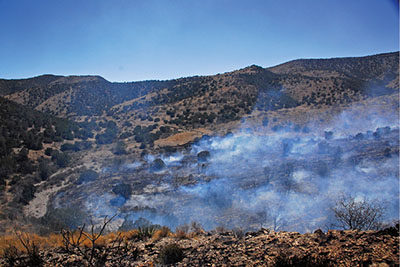
Figure 2. Informed habitat management can benefit mule deer and other ungulates, even in extremely xeric habitats such as Chihuahuan desert mountain ranges. Managers need to be aware of issues such as proper burning times and treatment return intervals to ensure that treatments maximize their potential to benefit wildlife while minimizing any potential harm. (Photo courtesy of M. Weisenberger.)
Considerations for Management
Habitat Types
These guidelines are based on a simple vegetation classification relevant to mule deer and other ungulates. Although habitat type classifications may differ for other classification systems (e.g., SW ReGAP, Muldavin et al., 2000), the habitat types used here are relatively generic, and other classification systems could easily be adapted to these guidelines. The eight habitat types (Table 1) for which mule deer habitat use, structure, and management recommendations are detailed are:
- Piñon-juniper woodlands (includes ponderosa pine)
- Oak-mountain mahogany shrublands
- Mesquite shrublands
- Sandsage shrublands
- Creosote shrublands
- Xeric shrublands (mixed lowland desert scrub and other shrubland types)
- Arid and semiarid grasslands
- Arroyos
|
Table 1. List of Eight Generic Habitat Types for Management of Mule Deer Habitat in the Hot Arid and Semiarid Regions of Southern and Eastern New Mexico (see Hoenes [2008] for additional details) |
|
|
Simplified |
Similar habitat types |
|
Piñon pine-juniper woodlands |
Ponderosa pine forest |
|
Piñon pine woodland |
|
|
Juniper woodland |
|
|
Oak-mountain mahogany shrublands |
Mountain mahogany |
|
Oak woodland |
|
|
Interior chaparral |
|
|
Montane scrub |
|
|
Creosotebush shrublands |
Creosotebush shrubland |
|
Mesquite shrublands |
Mesquite shrubland |
|
Mixed lowland desert scrub |
Mixed lowland desert scrub |
|
Sand sagebrush shrublands |
Sand sagebrush shrubland |
|
Other shrublands |
Four-wing saltbush |
|
Pickleweed shrubland |
|
|
Malpais lava scrub |
|
|
Tamarisk shrubland |
|
|
Mimosa shrubland |
|
|
Tarbush shrubland |
|
|
Acacia shrubland |
|
|
Arid and semiarid grasslands |
Mixed foothill-piedmont desert grasslands |
|
Piedmont desert grasslands |
|
|
Piedmont temperate |
|
|
Desert plains grasslands |
|
|
Shortgrass prairie |
|
|
Black grama lava grasslands |
|
|
Foothill-montane temperate grasslands |
|
|
Lowland basin grasslands |
|
|
Gypsum interdune swale grasslands |
|
Of these eight generic types, piñon-juniper woodlands (PJ) and oak-mountain mahogany (OMM) shrublands have the potential to provide the highest quality mule deer habitat in most of arid and semiarid New Mexico. Arroyos, arid and semiarid grasslands (AG), non-sand dune-associated mesquite shrublands, and sandsage shrublands on higher-quality sites have value for mule deer under certain circumstances and can be managed for mule deer, although their potential is lower than PJ or OMM. The remaining habitat types, including sand dune-associated mesquite and low-quality sandsage, have little potential as mule deer habitat, and recommendations for these types are provided only as considerations for managing these types for other purposes (e.g., conversion to grassland).
Soils
The ability of a site to provide water and nutrients for growth and development of plants is most strongly associated with factors that influence soil formation, as well as historical land use (Klemmedson and Tiedemann, 1995). Consequently, soils are an important consideration for any habitat improvement plan (Tiedemann and Lopez, 2004). Ideally, habitat management plans should incorporate ecological land classification systems based on habitat types and soil characteristics, including inherent fertility and potentials for grass, forb, shrub, or tree species. Because soil information is highly site-specific, the guidelines in this publication are based solely on habitat types. However, responses to habitat management treatments are more rapid and effective as soil fertility increases; thus, land managers should segregate habitat types by soil quality and soil potential to facilitate desired management outcomes (e.g., enhancement of shrubs versus grasses).
Soil classes based on Natural Resources Conservation Service Ecological Site Descriptions and Soil Survey wildlife habitat suitability matrices are useful for deriving soil potentials. Among other attributes, these provide estimates of potential productivity during years of above-normal, normal, and below-normal precipitation, and the potential of soil types to support herbaceous (grass, forb) or woody (shrub, tree) vegetation. Incorporating soil data is important because treatments designed to increase forage will show best results in higher-quality soils, and treatments designed to establish or facilitate woody browse will show highest success in areas where soils have a good shrub potential.
Management Units
Management units for mule deer should be based on the average home range of an adult doe, which is approximately 1 mi2. Ideally, randomized home ranges would be projected onto treatment areas to ensure maximum use of treatments by mule deer within any random home range. However, because mule deer use can be influenced by habitat characteristics other than structure and composition of habitat types, and because of the complexity associated with such a “moving windows”-based treatment allocation in a geographic information system, treatment areas are usually defined by habitat type and delineated by section lines modified by significant topographic (ridges, drainages, etc.) or other landscape features (roads, property boundaries, etc.). Although delineating management units by a modified section line approach results in variation in the size of units, this variation (typically in the range of 0.7–1.5 mi2) usually has little effect on overall management because many contiguous units are typically treated concurrently. Additionally, where noted in the HABITAT TREATMENTS section, following recommendations for minimum untreated and treated patch sizes eliminates concerns regarding variation in treatment unit size.
As noted above, management units will most often be associated with specific habitat types as defined by section boundaries modified by the contours of other landscape features. Contour boundaries often, but not always, tend to follow topographic features, such as ridgelines. Because management units are frequently designed to coincide with slightly modified section lines rather than soil or other biological boundaries, management units often are comprised of multiple habitat types, although they are usually dominated by one. Further, in areas where habitat types may intermingle (for example, shrub-steppe or grassland intermixed with piñon-juniper), management actions are complimentary.
Finally, because of their unique habitat attributes, all riparian and wetland areas merit attention for management, but these should be addressed on an individual basis where they occur on the landscape. Moreover, continual monitoring of riparian and wetland areas and modification of management treatments is warranted because management actions (particularly very large-scale treatments in higher precipitation piñon-juniper sites) may result in altered water flows and the subsequent expansion of both quantity and quality of riparian/wetland habitat over time.
Habitat Treatments
General Treatment Objectives and Guidelines
In general, the greatest enhancements in mule deer habitat can be attained by treating (1) areas that offer higher soil productivity and (2) areas that currently provide some deer habitat attributes. The following sections summarize treatments for general habitat types.
Piñon-Juniper Woodlands
Mule deer potential = HIGH
Mule deer use
Mule deer use PJ habitats primarily for cover (Figure 3), although diversity and in some cases abundance of food can be similar in PJ as compared to other habitat types. Where present, PJ receives the greatest proportion of use by mule deer of any vegetation type, and makes up more than 50% of female mule deer home ranges spread among differing structural classes of PJ. The importance of PJ as cover is apparent when more than 88% of female mule deer locations were within 660 ft of unmanaged PJ on the CRLRC. This proportion is less where mule deer have alternative cover choices; for example, where there is significant topographic relief, including ridges, mesas, relatively steep hills, and riparian breaks, mule deer will use these topographic features for cover, reducing their need for vegetative cover.
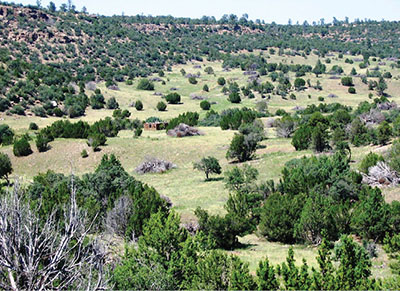
Figure 3. Mule deer require cover as well as forage. Thus, habitat treatments, such as thinning of the juniper canopy shown here, need to leave dense patches of trees or shrubs for cover adjacent to treatments or treatments may not be used by deer. (Photo courtesy of A. Darrow.)
Habitat structure
Management of PJ for mule deer is based on a “Rule of 4s.” Mule deer female home ranges average approximately 1 mi2, and ideally the following should apply to any random 1 mi2 simulated home range placed on the landscape. Management constraints make this generally impossible, so management of PJ is presented on a section basis.
The “Rule of 4s” states that for each section of PJ, 1/4 should remain unmanaged and should have at least 60% PJ cover (if existing cover is <60%, these areas should be allowed to develop to >60% cover), 1/4 should be thinned to no less than 30% PJ cover, and the remaining 2/4 can be thinned to no less than 10–15% cover. Further, no unmanaged stand should be less than 40 acres. This will create a mosaic in which 1/4 of each home range will be in unmanaged PJ ideal for security cover, 1/4 will be in a structural state that provides both minimal cover requirements and increased forage (30% cover), and 1/2 will be in a structural state that provides scattered thermal cover and optimal foraging attributes (10–15% cover). This structural distribution was associated with the highest levels of condition obtained by mule deer in several studies.
Ideally, no point within a home range should be more than 660 ft from cover. Spatial distribution of structural treatments is shown in Figure 4 for the coarsest scale (i.e., 160-acre, or quarter-section, treatments). Treatment allocation at this scale results in approximately 70% of the landscape being suitable for mule deer (i.e., <660 ft from cover). This distribution can be scaled down and mimicked at finer resolution (e.g., 40-acre, or quarter-quarter-section, treatments), but no heavy cover stand should be less than 40 acres. Treatment allocations at the quarter-quarter-section level result in 100% of the landscape being suitable for mule deer. See Figure 4 for an illustration of this concept.
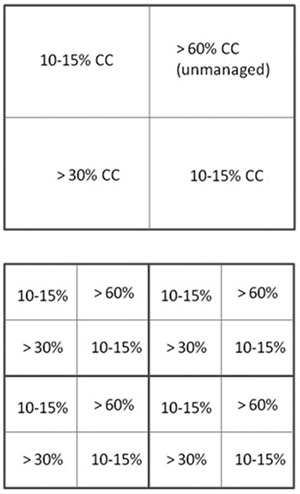
Figure 4. Illustrating the “Rule of 4s” and optimal distribution of treatments within a 1-mi2 treatment area. The upper distribution will result in approximately 70% of the landscape being used by mule deer. The lower distribution will result in 100% of the landscape being used by mule deer.
When both piñon and juniper are present, tree removal should emphasize juniper unless total cover cannot be maintained by piñon alone. Larger individual trees are preferred to facilitate summer thermal cover in the 10–15% cover treatment. All sizes should be maintained in the 30% cover treatment to provide both thermal (vertical) and obscurity (horizontal) cover.
Establishment of desired structure requires mechanical or fire treatments. Broadcast application of herbicides such as tebuthiuron is not recommended to decrease PJ cover. Treatment monitoring at the CRLRC has shown that broadcast herbicide application sufficient to achieve desired results (i.e., decrease PJ cover from >60% to 30%) resulted in a decrease of cover of preferred mule deer browse from around 15% down to less than 3% (Table 2). Individual tree treatments also decreased browse to less than 10% cover because browse often is established adjacent to or under the canopy of PJ trees.
|
Table 2. Percent Cover of the Piñon-Juniper Canopy and Preferred Woody Forages of Mule Deer on Mechanically Thinned, Herbicide-Thinned, Open Piñon-Juniper Savannah, and Unthinned Piñon-Juniper Woodland on the Corona Range and Livestock Research Center, Corona, NM |
||||
|
Cover |
Mechanical |
Herbicide |
Open |
Unthinned |
|
PJ |
10.8 |
27.3 |
17.2 |
62.4 |
|
Shrub |
9.8 |
2.4 |
18.4 |
11.0 |
Most PJ stands need some form of mechanical pretreatment before introducing fire due to low fine fuel loads and/or dense, laddered canopies on higher-quality sites (Bender, 2011, 2020). Primary treatment objectives when treating PJ woodlands focus on reducing overstory cover and maximizing the nutritional quality of the understory while maintaining security cover (Figures 5 and 6). Prescribed burning must be done with care, however, because even light burns in thinned PJ can result in a substantial kill of remaining trees, decreasing residual cover below desired levels (Figure 7). This may potentially be minimized by burning at optimal periods for mule deer nutritional management rather than periods designed to provide the greatest type-change effect (see Bender [2011] for guidelines on prescribed burning to benefit mule deer and other big game species). To maximize nutritional benefits of understory burning, nutrients need to be provided during mid-late gestation, lactation, and antler growth. These periods initiate in late April or May, so burns to benefit mule deer should ideally occur in March or April. Such burns will be significantly cooler than June or July burns, and thus may minimize mortality in the residual overstory (Bender, 2011).
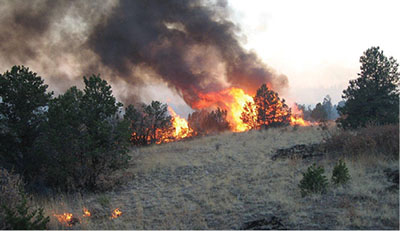
Figure 5. Burning and other treatments in piñon-juniper and other habitats can greatly enhance the nutritional quality of foods available to deer. Optimal management, however, requires blending forage and cover to meet all habitat requirements of mule deer. (Photo courtesy of A. Darrow.)
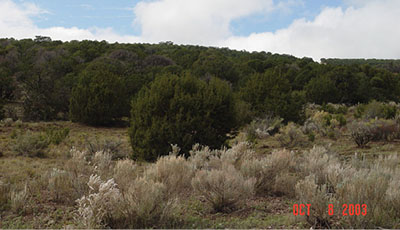
Figure 6. Note the lack of understory (food) in the unthinned juniper. Although stands such as this provide critical cover for deer, they should not be allowed to dominate the landscape. Ideally, they would provide no more than 25% cover of the range, well interspersed with more open patches. (Photo courtesy of M. Weisenberger.)
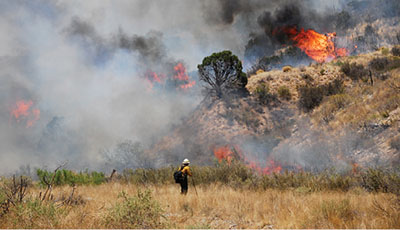
Figure 7. Intensity of burning in any habitat type needs to be closely monitored and carefully controlled. See NMSU Extension Circular 657, Burning for Big Game (Bender, 2011), for guidelines on burning intensity. (Photo courtesy of M. Weisenberger.)
Complete removal of PJ (type change) should not occur unless established shrub (e.g., OMM) communities exist and are able to provide deer all required cover elements and food. Invading PJ trees can be removed from other habitat types if sufficient habitat structure is available in these stands. Areas with high topographic relief allow for removal of more PJ if forage is limited by providing mule deer with alternative cover options. For enterprises that also manage for elk, elk favor areas with thermal cover in summer, so heavy to total removal of PJ will decrease habitat quality for elk significantly (Bender, 2020; Rosas-Rosas et al., 2019).
The preferred treatment for PJ is mechanical thinning to produce a savannah (Figure 8). However, sinuous strip removals can also be used to create the 30% cover treatment. Thinning should be used exclusively for the 10% treatment.
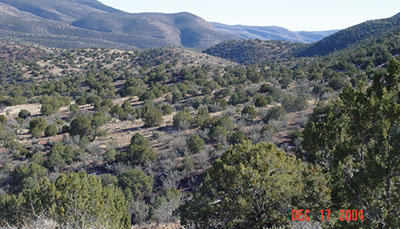
Figure 8. Thinning juniper in desert mountains can free more light and other nutrients for more valuable mule deer forages such as mountain mahogany. Thinning as a savannah, as pictured here, provides forage, thermal cover, and security cover in close proximity at any point on the range. (Photo courtesy of M. Weisenberger.)
Thinning. Randomly thin overstory juniper (or remove all juniper from stands where piñon provides >10–30% canopy cover) to the desired level of cover (i.e., >10% or >30%) to create a savannah structure (Figures 9 and 10). While treatments should emphasize retaining piñon over juniper, in areas where piñon has been severely stressed (e.g., by drought, disease, or competition with juniper), residual piñon often shows high mortality from prescribed burns during follow-up maintenance treatments. In these cases, managers may want to maintain an even balance of residual piñon and juniper, or even an emphasis on juniper.

Figure 9. Mechanical clearing can also increase forage production, although mechanical treatments alone do not increase forage quality to the extent that burning will. Here, juniper has been pushed over and piled, opening the understory for grass and forb growth. (Photo courtesy of A. Darrow.)
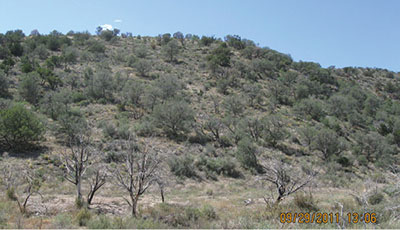
Figure 10. Selective removal of juniper by hand (chainsaw) thinning while leaving most piñon. Treatments like this open the understory for greater forage production while maintaining security and thermal cover. (Photo courtesy of M. Weisenberger.)
Strip removal. Piñon-juniper can be maintained in about 100-ft-wide sinuous strips that follow the contour of the landscape and occur between treatment openings. Width of treated (opened) strips should be less than 300 ft, and ideally vary throughout the strip to maximize edge and minimize straight-line sight distances.
For both treatment options, after piñon-juniper is removed or knocked down, sites should be burned in early spring to stimulate production of herbaceous species while favoring establishment of woody shrubs. If necessary, mechanically treated or burned areas should be seeded immediately prior to the wet season (July–August) or in late autumn or early winter to allow seeds additional scarification, especially if mixes include cool-season grasses.
Site maintenance. Sites with moderate soil productivity should be burned every 5–7 years, while sites with low soil productivity should be burned on 10- to 15-year intervals (Bender, 2011). Burns should be in early spring (March through early April) if establishment of shrubs is desired, or in late spring (April–early May) if establishment of grasses and forbs desired (Figures 11 and 12). Depending upon understory response, it may be desirable to seed the understory after mechanical disturbance or burning (see Wildlife Plantings and Special Seedings in the SPECIAL HABITAT TYPES section).
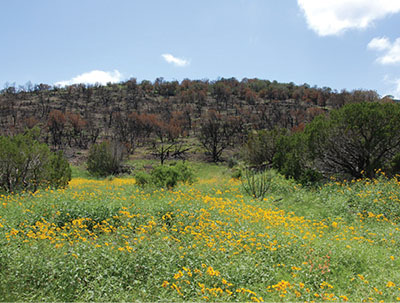
Figure 11. Forage responses after burning can be dramatic, even in the Chihuahuan desert. By increasing the quantity and quality of forage, productivity of deer populations can be greatly increased. (Photo courtesy of M. Weisenberger.)
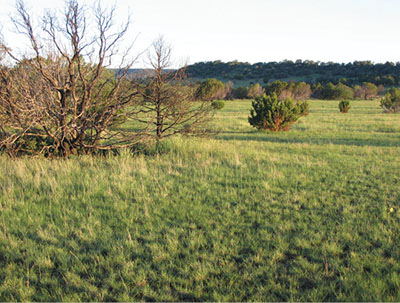
Figure 12. Grass and forb production can increase dramatically following prescribed burning in open piñon-juniper. Greenup of forage is also accelerated. (Photo courtesy of A. Darrow.)
Habitat management guidelines
General description: Dominated by piñon-juniper woodland or characterized by scattered piñon-juniper mixed with oakbrush, mountain mahogany, or xeric shrublands, with grassland components interspersed. Soil productivity is typically fair to good with grass/forb/shrub potential, or poor to fair with forb/shrub/piñon-juniper potential. Primary management objectives include maintaining optimal cover attributes on approximately 1/4 of the treatment area and limiting juniper overstory (or reducing juniper canopy in stands while maintaining a piñon overstory) to increase the production of understory herbaceous forages and browse. Secondary objectives include encouraging the establishment of shrub species if they are lacking or present with limited cover (<10%).
Objective 1: Maintain >1/4 of each section in unmanaged PJ, ideally with cover >60%.
Objective 2: Reduce overstory canopy cover to about 30% in 1/4 of PJ treatment area and to about 10–15% in 1/2 of treatment area.
Strategy 1: If piñon is present at >30% canopy cover, completely remove all juniper by cutting or other mechanical manipulations. Either scatter or pile the slash in cleared areas.
Strategy 2: If juniper is the only cover present, thin or clear juniper in about 100-ft-wide strips that contour the landscape between clearings. Maintain a distance of about 300 ft between strips. Slash can be left or piled.
Strategy 3: Thin PJ to about 30% combined canopy cover, with remaining trees left in mixed stands. Leave downed trees to facilitate growth of herbaceous and shrub vegetation if cattle grazing is present.
Objective 3: Minimize density of remaining piñon trees.
Strategy 1: Reduce cover of remaining piñon to 10–30% by mechanically thinning stands.
Objective 4: Increase production of herbaceous forages and encourage the establishment of shrub species.
Strategy 1: Broadcast burn the entire treatment area in early spring (March–April).
Strategy 2: If necessary, seed desired shrub/forb/grass mixtures in cleared areas prior to the wet season (July–August) or prior to snow cover (late fall or early winter). Follow instructions listed under Wildlife Plantings and Special Seedings in the SPECIAL HABITAT TYPES section for seedings.
Objective 5: Maintain site integrity.
Strategy 1: Burn thinned sites on a 5- to 7-year rotation (10–15 years on poorer sites) in early spring (March–May) to kill re-establishing juniper and rejuvenate herbaceous and shrub canopies.
Strategy 2: Once shrub communities become well established, site maintenance should follow that described for dominant shrub communities if different than PJ maintenance recommendations.
Ponderosa pine subgroup
General description: Ponderosa pine woodland dominant or co-dominant with PJ. Soil productivity is fair with a grass/shrub/ponderosa pine or piñon-juniper potential. Primary management objectives will be aimed at reducing overstory canopy cover and increasing the production of high-quality forages.
Objective 1: Reduce overstory canopy cover.
Strategy 1: Reduce canopy coverage to 25–33% by mechanically thinning forested stands and removing all juniper.
Objective 2: Increase production of herbaceous forages and shrub species.
Strategy 1: Broadcast a low-intensity fire throughout the entire unit during spring (March–early May).
Strategy 2: If desired shrub/forb species are absent, the area can be seeded prior to the wet season or prior to snowfall (late fall–early winter).
Objective 3: Maintain site integrity.
Strategy 1: Burn units in a 10- to 12-year rotation using a low-intensity prescribed burn during early spring.
Oak-Mountain Mahogany Shrublands
Mule deer potential = HIGH
Mule deer use
Mule deer use OMM shrublands for both food and cover. Availability of browse is high in OMM habitats as compared to other habitat types in arid New Mexico, but much of this habitat type is in late succession, which limits availability of the most nutritious browse. Denser shrublands and overstory oak also provide horizontal and vertical cover for mule deer. Scattered juniper or piñon provide thermal cover for mule deer in OMM stands, but PJ cover should be controlled to maintain OMM dominance.
Habitat structure
Structure of OMM should provide both security cover and forage. Security (and thermal) cover is best provided by late successional shrubs or oak trees, while forage is best provided by browse and herbaceous forage associated with early successional OMM. Similar to PJ, optimal use occurs if mule deer are no farther than 660 ft from cover.
Defining successional status of OMM shrublands is complicated by differing growth rates associated with aspect, slope, precipitation, soil, and other factors. In general, early succession can be considered less of an age issue and more of a structural issue. If shrubs are tall enough to shield bedded deer, then successional status of OMM is likely optimal for provision of browse, herbaceous foods, and some security cover. If height of shrubs or trees is tall enough to shield a standing deer, much of the browse potential of OMM is past optimal, herbaceous forage will be increasingly shaded out, and browse nutritional quality has declined, but both horizontal and vertical cover will be approaching optimal. For areas with oaks capable of achieving a low tree canopy, production of acorns increases with successional status.
Because of the need to provide all mule deer habitat requisites in OMM, creation of structure should follow a similar “Rule of 4s” as PJ, with 1/4 of the treatment area maintained in late succession and the other 3/4 in earlier successional classes. For optimal use by mule deer, each of the quarters should be present in a quarter-quarter-section; this allows mule deer to never be more than 660 ft from cover (Figure 4).
Treatments to create and maintain early successional OMM should be tailored to site conditions; more mesic (higher moisture level) habitats require more frequent treatment schedules. This is particularly true in areas with higher cover of oakbrush. Oakbrush clones can become extremely dense with favorable growing conditions, shading out herbaceous forages and eventually precluding movements of mule deer. Such areas require more frequent burning or mechanical treatments to keep oakbrush in early successional status while concurrently minimizing density of clones to allow herbaceous production and use by mule deer. Alternatively, to thin oakbrush sprouts and improve overall forage quantity and quality, clones can be seeded prior to the wet season (mid-July–August) with a grass/forb mixture.
Early successional treatments should be burned every 10–15 years to maintain a mosaic of varying ages and stem densities. To further increase diversity of structure and composition, establish a treatment rotation in which 1/3 of early succession is re-treated every 12–15 years, with 5-year lags between adjacent treatment blocks. This will also maintain a landscape mosaic where the landscape will be divided fairly evenly among late and 0 to 5, 5 to 10, and 10 to 15-year-old age or structural classes. Establishment of treatment quarters on each quarter-section (160 acres) provides for full use of the landscape by mule deer.
Habitat management guidelines
General description: Dominated by late seral oak and mountain mahogany stands interspersed with piñon-juniper and semi-desert grassland communities. Soil productivity is fair to good with grass/shrub/piñon-juniper potential. Primary management objectives include rehabilitating or reestablishing shrub communities (Figure 13). Thinning of the forested portions of units to reduce overstory canopy cover is a secondary objective. Also included in these recommendations are strategies for rejuvenating remnant mountain brush communities.
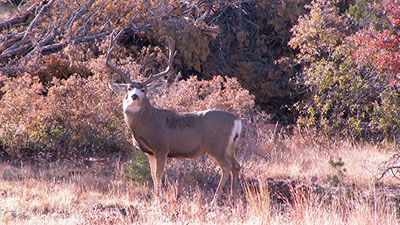
Figure 13. Mechanical thinning of juniper can also increase shrub response, such as seen here with oakbrush, which greatly benefits mule deer because of greater drought hardiness than seen with forbs. (Photo courtesy of M. Rearden.)
Objective 1: Maintain 1/4 of each 1 mi2 treatment area in untreated OMM.
Objective 2: If present, thin piñon-juniper to 10–15% cover.
Strategy 1: Remove piñon-juniper from areas with greater than about 10% cover by cutting or other mechanical treatments (do not chain or cable unless in areas where OMM will be disturbed to earlier successional classes).
Objective 3: Rejuvenate OMM in remaining 3/4 of management area.
Strategy 1: Burn >25% of management units in early spring (March–April).
Strategy 2: Chain and burn denser, established oakbrush stands across >25% of the unit if present (usually moister sites).
Strategy 3: Crush oakbrush or mountain mahogany stands across >25% of the unit if present (usually moister sites).
Strategy 4: Treat remaining early successional area in the same manner to rejuvenate all treated OMM within 4–5 years.
Objective 4: Increase the production of herbaceous forages.
Strategy 1: Seed with grass/forb mixture following burning or mechanical treatments in mid-July through August following onset of monsoon.
Strategy 2: For mechanically treated areas, seed area before second chaining or after initial soil disturbance; harrow or drag area to prepare seedbed if soil disturbance is low.
Objective 5: Maintain site integrity.
Strategy 1: Burn units on a 10- to 15-year rotation using a low-intensity prescribed burn in early spring (March–April).
Strategy 2: Stagger burning of early successional treatments to 1/3 every 4–5 years to further increase diversity of structure and composition.
Arroyos
Mule deer potential = HIGH
Mule deer use
Mule deer use of arroyos can be high due to the presence of preferred habitat components that provide both food and cover, including greater cover of mesquite, littleleaf sumac, desert willow, ephedra, four-wing saltbush, cliff fendlerbush, skunkbush, and other woody and herbaceous species. These habitat attributes provide higher-quality forage and cover opportunities for mule deer than are usually present in surrounding habitat types, most commonly creosote, other shrublands, or AG.
Habitat structure
Arroyos provide both vegetative and topographic vertical and horizontal cover, which is often the factor that most limits mule deer use of associated habitat types typified by low topographic relief, such as AG and creosote shrubland. Arroyos can also provide much greater cover of preferred browse species and often produce more herbaceous forage because of increased soil moisture, particularly when compared with creosote and other xeric shrublands. While it is important to maintain arroyos in all habitat types, they are especially critical in AG, creosote shrubland, and other xeric shrubland habitats. These typically provide little or no cover (all) or food (creosote shrubland and other xeric shrublands). Arroyos thus receive the majority of mule deer use in these habitat types and are important corridors to extend the use of habitat types that would otherwise be limited by lack of cover (e.g., AG).
Maintaining high structural and species diversity in arroyos within a buffer of about 50–100 ft along each bank provides needed cover in open habitat types. Mule deer will preferentially use open habitats within approximately 660 ft of cover.
Habitat management guidelines
Management of arroyos is limited to individual plant treatments to remove undesirable species (e.g., creosote) and seeding to enhance development of browse and herbaceous forages.
Objective 1: Maintain a 50- to 100-foot buffer along arroyos during other management treatments (conversions, prescribed burns, etc.).
Strategy 1: Avoid broadcast herbicide or fire application within buffers during initial treatments for type conversions.
Objective 2: Individually treat plants to remove undesirable species such as creosote.
Strategy 1: Individually treat (preferably mechanically remove) creosote shrubs within the arroyo and corridor.
Strategy 2: Individually treat (preferably mechanically remove) creosote within the arroyo. Feather creosote treatments outward from arroyo through corridor with density increasing outward from the arroyo.
Objective 3: Establish preferred browse and herbaceous forages if lacking.
Strategy 1: Seed grass/forb/shrub mixtures in and adjacent to arroyos prior to the wet season.
Arid and Semiarid Grasslands
Mule deer potential = MODERATE
Mule deer use
Mule deer use of AG is limited primarily by lack of cover. Although AG provides a high diversity and quantity of mule deer foods, they are seldom used unless AG is in close proximity to other taller vegetation types or topographic cover; use can be extremely high in areas with high and diverse topographic relief. Mule deer seldom forage more than 660 ft from cover; thus, use of the majority of AG is low because of a lack of screening or overstory woodland or shrubland cover. Livestock grazing can increase mule deer use of AG by removing the grass overstory and decreasing foraging time for forbs and early phenology grasses; however, excessive grazing can result in high use of palatable shrubs, or in a carpeting of unpalatable shrubs, decreasing the quality of AG for mule deer.
Habitat structure
Primary treatment objectives in AG habitat types focus on recurring fire, establishing woody cover, and diversifying forage options through seeding of quality forages and/or establishment of forage plots throughout grassland and shrubland areas. Establishment of security structure in AG is the greatest challenge in managing AG for mule deer in areas where cover-providing vegetation types are more than 660 ft from AG areas. Only AG within 660 ft of structures providing security and thermal cover should be considered “used” by mule deer. Cover can also be provided by topography (e.g., arroyos), and use of AG by mule deer can be extremely high where topographic relief is high and diverse. Establishment of cover is most effective where existing topography (e.g., arroyos [small or large], small hills, etc.) is used as patches or corridors to expand or establish vegetative cover.
Shrub cover can be established by seeding a forb/shrub mixture, seeding other shrubs without a forb component (primarily four-wing saltbush, skunkbush, and littleleaf sumac), or transplanting oakbrush, skunkbush, or littleleaf sumac saplings/clones during early spring (Monsen et al., 2004). If placed in patches, shrub establishment areas should be at least 1 acre in size, with transplants scattered throughout the area. Ideally, a mosaic of patches and openings should be created within the treatment area. Once shrubs are established, they should be maintained following treatment guidelines for OMM or xeric shrublands, with the exception that cover patches need not meet any minimum size requirement. At higher elevations characterized by piñon-juniper, clones of oakbrush can be transplanted to facilitate development of shrub cover in grasslands lacking such cover. Where it occurs, invading PJ should be maintained at 10–30% cover.
To develop diversity in herbaceous forages, units with moderate soil productivity should be burned every 5–7 years in early spring, and every 10–15 years in late spring if soils with low productivity ratings dominate (Bender, 2011). The response to fire can be enhanced by seeding a forb/shrub mixture (e.g., Ladak alfalfa and shrubs such as winterfat and those noted above; see Objective 3 under Habitat management guidelines in this section) immediately prior to the wet season. Areas with significant browse presence (>20% cover) should follow the longer (10–15 years) burning cycle to maintain cover of woody browse.
Habitat management guidelines
General description: Dominated by semiarid grassland habitat types on areas with fair to good soil productivity and grass, forb, and shrub potential. Primary management objectives include increasing the production of high-quality herbaceous species (grasses and forbs), while secondary objectives involve establishing woody cover. Alternative strategies include establishing wildlife forage plantings
Objective 1: Maintain existing PJ cover at 10–30%.
Strategy 1: Mechanically thin PJ if cover is >30%.
Objective 2: Maintain existing shrub cover of desirable species.
Strategy 1: Construct firebreaks around existing shrub communities to protect from AG burning cycle.
Strategy 2: Construct firebreaks along arroyos to protect shrubs from AG burning cycle. Firebreaks should buffer each side of the arroyo by 50–100 ft.
Objective 3: Increase forb component and enhance quality/palatability of existing grasses.
Strategy 1: Burn 10–25% of treatment units annually with cool fires in early spring (March–April).
Strategy 2: Seed forb/shrub mixtures near cover or topographic relief (drainages, etc.) prior to the wet season.
Objective 4: Establish areas of cover where lacking.
Strategy 1: Seed forb/shrub mixtures in arroyos in late July–August during good monsoon years if woody vegetation is lacking. See ARROYOS section for management of existing woody vegetation if present.
Strategy 2: Seed forb/shrub mixtures adjacent to topography after burning in spring prior to summer rains. Excluding cattle for up to 3 years may be necessary to allow establishment of seeded shrubs.
Strategy 3: Seed shrubs or plant oakbrush, skunkbush, or littleleaf sumac in 1- to 3-acre patches on or adjacent to local topographic features such as small hills or depressions. Plantings are best established during late July or August in association with monsoons. Cover of transplanted clones should be >10% of establishment area. Protect newly established plantings from fire.
Strategy 4: PJ can be planted or encouraged on the margins of AG. Transplanted PJ should be in patches associated with local topography as described in Strategy 3.
Objective 5: Maintain site integrity.
Strategy 1: Burn units every 5–10 years in early spring, except for areas with newly established shrub communities.
Strategy 2: Once shrub communities become well established, site maintenance should follow that described for OMM or xeric shrublands.
Mesquite Shrublands
Mule deer potential = MODERATE (non-sand dunes only)
Mule deer use
The condition of female mule deer in autumn was positively related to the proportion of locations in mesquite shrublands during the growing season in the Chihuahuan desert, highlighting the forage value of this habitat type. While browse species are rare, mesquite shrublands contained the most ground cover of forbs of all habitat types in the San Andres study area. Additionally, mesquite pods are high in crude protein and digestible energy, and provide mule deer with a forage resource that is usually readily available in late spring. Mesquite shrublands also provide both vertical and horizontal cover for mule deer through both mesquite trees and other associated species (e.g., littleleaf sumac). Consequently, mule deer does consistently selected for this habitat type throughout the year.
Habitat structure
Mesquite shrublands typically form an open to dense savannah structure that provides both food and cover at lower densities and primarily cover at higher densities. Koenen and Krausman (2002) found that desert mule deer in Arizona used mesquite shrublands when mesquite was less than 60% of ground cover and avoided them when mesquite made up at least 60% of ground cover. It is not clear whether or not these findings were related to a cover “threshold” or were related to decreased forage abundance caused by mesquite’s competitive exclusion of herbaceous and woody browse plants. Because honey mesquite cover was approximately 45% in the San Andres Mountains of New Mexico, these habitats may be close to reaching a threshold where use by mule deer may decline in areas of low disturbance.
Similar to the “Rule of 4s” outlined for PJ, mesquite shrublands structure should include 1/4 of treatment areas in late succession (>40% cover), 1/4 in less than 30% cover, and 2/4 in at least 10% cover. To provide optimal blocks of cover, untreated areas and thins of approximately 30% should be 10–20 acres in size. Maximum use of the landscape by mule deer will occur when all four treatments are present in the same quarter-section (160 acres).
Habitat management guidelines
General description: Non-sand dune areas dominated (>30% cover) by mesquite, often interspersed with other shrubs (including littleleaf sumac, ephedra, and creosotebush) and generally with a relatively abundant grass and forb understory, especially on higher-quality sites or sites with less total mesquite cover. Mesquite shrublands on sand dunes are not considered mule deer habitat and should not be managed following these guidelines.
Objective 1: Maintain 1/4 in >40% but <60% mesquite cover.
Strategy 1: If mesquite cover is >60%, mechanically thin to 40–60% cover.
Strategy 2: If mesquite cover is >60%, individually treat plants with herbicide to decrease cover to 40–60%.
Objective 2: Thin 1/4 of treatment area to about 30% mesquite cover.
Strategy 1: Mechanically thin mesquite in savannah by cutting or crushing.
Strategy 2: Mechanically thin mesquite in strips by cutting, crushing, or chaining. Residual strips should be around 100 ft in width with cleared strips of 150–200 ft.
Strategy 3: Herbicidal treatment of mesquite to substantially decrease cover is not recommended because of negative effects on other woody browse species. Individual trees can be sprayed to accomplish thinning objectives.
Strategy 4: Prescribe burn treatment areas in late winter or early spring (February–April) to decrease mesquite cover. Care must be used with fire intensity to avoid removing all existing mesquite.
Objective 3: Thin remaining 1/2 of management area to about 10% mesquite cover.
Strategy 1: See Objective 2 for thinning strategies.
Objective 4: Maintain PJ canopy if present at 10–15% cover.
Objective 5: Maintain open canopy mesquite.
Strategy 1: Prescribe burn in late spring on a 10- to 15-year interval.
Sandsage Shrublands
Mule deer potential = LOW (high soil quality sites only)
Mule deer use
Sandsage is generally negatively associated with most measures of mule deer habitat quality, likely because this habitat is found primarily on sandy soils that support few herbaceous species with highly variable palatability to deer. Sandsage does provide security cover, and other shrubs occasionally present, such as littleleaf sumac, can provide mule deer with thermal cover. In the absence of fire, sandsage canopies on higher-quality sites can be quite dense, limiting both understory herbaceous development and mule deer movement.
Habitat structure
Sandsage is generally a low management priority for mule deer. The exception to this is where it occurs on more fertile sites with a relatively abundant herbaceous understory. In these areas, limiting shrub densities with mechanical treatment or fire can enhance production of herbaceous forages while maintaining security cover associated with sandsage. In these more fertile sites, sandsage is also of higher palatability to mule deer, and thus significant resprouting after fire can increase browse availability to deer as well.
Prescribed burning in spring can reduce the height of sandsage by more than 50% and cover by more than 75%, while summer and autumn burns can reduce these attributes by more than 90%. Because the primary value of sandsage is likely related to cover, burning should be restricted to spring burns, or mechanical treatments (chaining or crushing) can be used to thin sandsage. Additionally, patches of littleleaf sumac and other tall shrubs or trees are heavily used by mule deer in sandsage shrublands, and care must be taken to preserve these patches and individuals during sandsage treatments.
About 1/4 of each treatment area should be maintained in unmanaged sandsage to maintain security cover if treatments should reduce cover in treated stands below minimum requirements. The remaining 3/4 of treatment units can be treated with prescribed burning in spring to decrease cover of sandsage to less than 50%. If lacking, grass/forb/shrub mixtures can be seeded immediately prior to or during the monsoon (late July–August) on sites with higher soil quality. Once treated, sandsage areas can be burned on 10- to 15-year or longer intervals to maintain early successional status of sandsage if cover exceeds 50%.
Habitat management guidelines
General description: Dominated by sandsage interspersed with alkali and grama grasslands with poor to fair soil productivity and grass, forb, and shrub potential. Primary management objectives include limiting sandsage density to increase production of high-quality herbaceous species (grasses and forbs) on higher-quality sites while maintaining an adequate shrub overstory for cover. Lower-quality sites lacking an herbaceous understory should not be managed for mule deer.
Objective 1: Maintain existing littleleaf sumac and mesquite trees.
Strategy 1: If burning, drag a fire break around clumps to be maintained for thermal and security cover.
Objective 2: Maintain 1/4 of treatment area in unmanaged sandsage.
Objective 3: Increase forb component and enhance quality/palatability of existing grasses.
Strategy 1: Burn treatment units in early spring to decrease cover of sandsage to <50%. Height of sandsage is less of a concern than limiting total cover.
Strategy 2: Seed grass/forb/shrub mixtures near cover or topographic relief (drainages, etc.) prior to the wet season.
Objective 3: Maintain security and thermal cover.
Strategy 1: Maintain shrub canopy cover of 20–33% with no limitations on shrub height.
Strategy 2: Preferentially maintain mesquite and littleleaf sumac shrubs.
Objective 4: Maintain site integrity.
Strategy 1: Burn units every 10–15 years in early spring (except for areas with newly established shrub communities) if sandsage cover exceeds 50%.
Creosote Shrublands and Other Xeric Shrublands
Mule deer potential = VERY LOW (non-deer habitat)
Mule deer use
Creosote shrublands receive little use and provide little food or cover value for mule deer unless other species or habitat types are present (Figure 14), such as scattered individuals or clumps of mesquite and littleleaf sumac, or arroyos. Other shrubland types receive some use depending upon the species composition, but are of much lower overall value than PJ, OMM, or non-sand dune mesquite shrublands. If cover of browse species (e.g., four-wing saltbush) is high in xeric shrublands, other shrublands can be alternatively managed following the guidelines for sandsage.
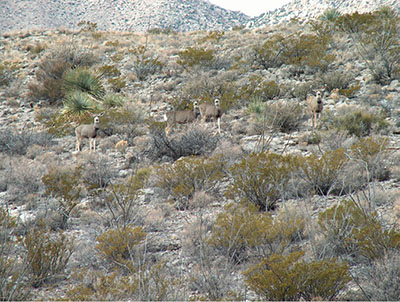
Figure 14. Even low-quality habitat types like creosote shrublands can provide habitat for mule deer if the creosote canopy is controlled. (Photo courtesy of C. Rodden.)
Arroyos in creosote shrublands and other shrubland habitat types can receive extensive use by mule deer. Such arroyos warrant protection and specific management actions that differ from management of creosote shrublands and other xeric shrublands.
Creosote shrublands should be a low priority for management for mule deer. However, where conversions of creosote shrublands to AG are occurring, maintaining some habitat structure and managing some associated habitat types (e.g., arroyos) can result in greater use of new grasslands by mule deer.
Habitat structure
Conversion to AG is probably the best use of creosote shrublands for mule deer, particularly if existing mesquite, four-wing saltbush, and littleleaf sumac can be maintained (or established following conversion). Large-scale creosote conversions most commonly involve aerial spraying with tebuthiuron or other herbicides. Thus, an untreated buffer of approximately 50–100 ft along arroyos in creosote shrublands should be established to preserve habitat components associated with arroyos that are valuable to mule deer (increased presence of forage species and vertical and horizontal cover).
Primary treatment objectives in xeric shrublands (shrub-steppe) focus on rehabilitating existing stands of shrubs and maintaining habitat quality over time by prescribed burning. Where present, PJ should be limited to 30% cover, or maintained if present at less than 30% cover. After removing the excess PJ overstory, rejuvenate shrub communities with prescribed burning in early spring. This should be done on a portion (<20% annually) of the treatment area to maintain adequate security cover. Units should be burned every 10–15 years to maintain a mosaic of varying ages and stem densities.
Habitat management guidelines
General description: Creosote shrublands and other xeric shrublands dominated by creosotebush and tarbush with limited presence of preferred mule deer browse species. Both shrubland types provide minimal forage or cover attributes for mule deer, except for arroyos. These types have little potential for direct management for mule deer except for adjacent arroyos. Primary management objectives therefore include increasing the production of high-quality herbaceous species (grasses and forbs), while secondary objectives involve the establishment of woody cover.
Objective 1: Maintain existing PJ, mesquite, or littleleaf sumac if present.
Strategy 1: Avoid herbicide applications to areas with these species during type change conversions.
Objective 2: Type conversion to grassland.
Strategy 1: Seed grass/forb/shrub mixtures near cover or topographic relief (drainages, etc.) prior to the wet season if the entire area is treated with broadcast herbicides.
Strategy 2: Maintain existing mesquite and littleleaf sumac trees or clumps for vertical and horizontal cover whenever possible during conversions.
Objective 3: Maintain existing vegetation within 50–100 ft of arroyos characterized by change in vegetation composition.
Strategy 1: See ARROYOS section for management guidelines.
Objective 4: Maintain site integrity.
Strategy 1: See ARID AND SEMIARID GRASSLANDS section for management guidelines following type change.
Special Habitat Types
Mule deer potential = HIGH
Riparian
Primary treatment objectives in riparian corridors include increasing cover where absent and controlling invasion by juniper and saltcedar. All piñon-juniper and saltcedar should be removed and regeneration controlled from treatment sites unless other woody cover is lacking; in these instances, retain some piñon until shrubs are well-established. Riparian corridors lacking woody cover should be planted with desirable shrub and tree species, such as willows and cottonwood in wetter areas and littleleaf sumac or skunkbush in drier sites (Table 3). Land managers should consult their local Cooperative Extension Service specialist (https://aces.nmsu.edu/county/) or New Mexico State Forestry officer (https://www.emnrd.state.nm.us/SFD/contact.html) for the best planting and control options for their specific geographic area. Riparian areas can also be initially burned and seeded with shrub/grass/forb mixtures. Riparian areas should be managed on a case-by-case basis.
|
Table 3. List of Common Shrub Plantings That Provide Valuable Mule Deer Forage and Cover in Lower-Elevation, Dry Habitats of New Mexico |
||
|
Species |
Uses |
Sites |
|
Skunkbush sumac |
Excellent forage |
All |
|
Littleleaf sumac |
Decent forage, excellent cover |
All |
|
Wax currant |
Good forage |
Mesic |
|
Golden currant |
Good forage (wildlife and human) |
Mesic |
|
Hackberry |
Good forage |
All |
|
Fernbush |
Good forage |
Mesic |
|
Sandcherry |
Good forage (wildlife and human) |
All |
|
New Mexico elderberry |
Good forage (wildlife and human) |
All |
|
Desert willow |
Good cover |
Mesic |
|
Winterfat |
Fair forage |
All |
Wildlife Plantings and Forage Seedings
Establishment of wildlife plantings or forage plots is a management treatment suitable primarily to PJ, OMM, riparian, and AG habitat types where precipitation exceeds approximately 10–12 inches annually. Since much of arid New Mexico receives less than 12 inches of precipitation, seeded species should be perennial and tolerant of dry conditions. Because a diversity of forages is key to ensuring that quality foods are available throughout the year, seed mixtures should include more than one species and emphasize a high-quality forb and one or more cool-season grasses and/or shrubs. Last, because plantings are often expensive and frequently fail, simplicity is key to any cost-effective seed mixture. For example, a simple mixture of Ladak alfalfa, a shrub such as winterfat, and a cool-season grass such as Indian ricegrass or western wheatgrass is a good basic seeding mix (Figure 15). All of these species are extensively employed in rangeland rehabilitation (Monsen et al., 2004), are of fair (winterfat) to excellent (alfalfa, Indian ricegrass) forage quality, and provide their highest forage quality during different seasons (alfalfa in spring–summer, winterfat in autumn–spring, and cool-season grasses in both spring and autumn). Other shrubs (e.g., mountain mahogany) or forbs (e.g., small burnett) can be added in moister sites if desired, especially in riparian sites (Table 3). Forage plantings should be made in close proximity to cover to maximize mule deer use (Figure 16). Also, while shrubs can germinate from seed, plant establishment is usually far better when planting seedlings or using other vegetative propagation. Seedlings of most species are available from New Mexico State Forestry, and excellent reference information on seeding rates and times for most species can be found in Monsen et al. (2004).
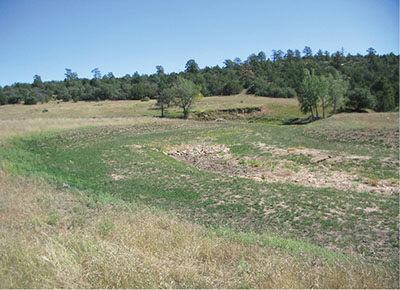
Figure 15. Forage planting, like the dryland alfalfa pictured here, can provide extremely palatable, high-quality forage for mule deer. Planting can increase condition of deer significantly, increasing population productivity and quality of antler development. (Photo courtesy of A. Darrow.)
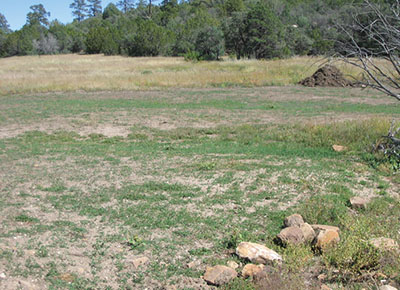
Figure 16. Forage planting should be in close proximity to cover, such as the unthinned piñon-juniper in the background, to receive maximum use by mule deer. (Photo courtesy of A. Darrow.)
Most seedings in arid and semiarid New Mexico should emphasize Ladak or other appropriate dryland alfalfa because of their excellent nutritional value for mule deer. Plantings of dryland alfalfas need not be irrigated, but successful establishment can be increased by early irrigation. Once established, no irrigation is needed, and dryland alfalfas show excellent long-term persistence once established. If well-established, burning during early spring every 5–10 years may be sufficient to renew vigor of plantings (this regime is also compatible with many shrubs and cool-season grasses that may be included in seed mixes). If used specifically as forage plots, plantings should be 5–20 acres in size with 1–4 plantings per section (note that these recommendations also work well for underseeding in all treatments outlined previously). Seeding rates for alfalfa are 5–10 lb/acre, and aerial or broadcast seeding following chaining or harrowing works well for establishment in all vegetation types outside of specific food plots. A second drag for covering seeds has increased germination in some areas and decreased establishment in others. The key for dryland alfalfa is to not cover seeds with more than 1/16–1/8 inch of soil or germination will be extremely low. Ideally, disturbing soil by harrowing under good soil moisture conditions or immediately prior to high-intensity rainfall soon followed by surface broadcasting provides ideal conditions for germination.
If browse is rare, plantings should include browse establishment along with alfalfa. Also, because of their rarity, cool-season grasses should be considered to provide critical nutrition during the late gestation and early lactation periods (Bender, 2020).
Because most seedbed preparation results in highly variable planting depths, combining alfalfa with cool-season grasses and shrubs often results in higher overall germination than single-species plantings because seeds have different preferred planting depths. Seeding in late autumn or early winter may also increase germination by providing additional scarification of seeds, especially for cool-season species. Once established, plantings require little annual maintenance. Early spring burning may be beneficial on approximately 5- to 10-year intervals to thin alfalfa and aggressive shrub plantings. As with riparian habitats, wildlife plantings are best established following individual site consultations.
Literature Cited
Allison, C.D., J.L. Holechek, T.T. Baker, J.C. Boren, N.K. Ashcroft, and J.M. Fowler. 2007. Rapid assessment methodology for proactive rangeland management. Rangelands, 29, 45–50.
Bender, L.C. 2007. Growth, health, and impacts of a pioneering elk herd on and adjacent to Chaco Culture National Historic Park, New Mexico [Final Report]. Las Cruces: U.S. Geological Survey, New Mexico Cooperative Fish and Wildlife Research Unit.
Bender, L.C. (Compiler). 2010. Identification of factors limiting mule deer populations in the Greater San Andres Mountains with emphasis on effects of chronic wasting disease and risks associated with chronic wasting disease [Final Report]. Las Cruces: New Mexico State University Department of Extension Animal Sciences and Natural Resources.
Bender, L.C. 2011. Burning for big game [Circular 657]. Las Cruces: New Mexico State University Cooperative Extension Service.
Bender, L.C. 2020. Elk, deer, and pinyon-juniper: Needs, what works, and what doesn’t. In K. Malcolm, B. Dykstra, K. Johnson, D. Lightfoot, E. Muldavin, and M. Ramsey (Compilers), Symposium proceedings on piñon-juniper habitats: Status and management for wildlife - 2016. [Proceedings RMRS-P-77] (pp. 34–58). Fort Collins, CO: United States Forest Service, Rocky Mountain Research Station.
Bender, L.C., L.A. Lomas, and J. Browning. 2007a. Condition, survival, and cause-specific mortality of adult female mule deer in north-central New Mexico. Journal of Wildlife Management, 71, 1,118–1,124.
Bender, L.C., L.A. Lomas, and T.K. Kamienski. 2007b. Habitat effects on condition of doe mule deer in arid mixed woodland-grassland. Rangeland Ecology and Management, 60, 277–284.
Bender, L.C., J. Boren, H. Halbritter, and S. Cox. 2008. Population dynamics and habitat relationships of mule deer and pronghorn on the Corona Range and Livestock Research Center, New Mexico [Annual Report]. Las Cruces: New Mexico State University Department of Extension Animal Sciences and Natural Resources.
Bender, L.C., J.C. Boren, H. Halbritter, and S. Cox. 2011. Condition, survival, and productivity of mule deer in a semiarid grass/woodland in east-central New Mexico. Human-Wildlife Interactions, 5, 276–286.
Bender, L.C., B.D. Hoenes, and C.L. Rodden. 2012. Factors influencing survival of desert mule deer in the greater San Andres Mountains, New Mexico. Human-Wildlife Interactions, 6, 245–260.
Bender, L.C., and O.C. Rosas-Rosas. 2016. Compensatory puma predation on adult female mule deer in New Mexico. Journal of Mammalogy, 97, 1399–1405.
Bender, L.C., and B.D. Hoenes. 2017. Costs of lactation to body condition and future reproduction of free-ranging mule deer. Mammalia, 81, 329–338.
Bender, L.C., and B.D. Hoenes. 2018. Age-related fecundity of mule deer in south-central New Mexico. Mammalia, 82, 124–132.
Caltrider, T., and L.C. Bender. 2018. Relationships between landscape greenness and condition of elk, mule deer, and pronghorn in New Mexico. Rangeland Ecology and Management, 71, 259–265.
Drake, B., and P. Todd. 2002. A strategy for control and utilization of invasive juniper species in Oklahoma: Final report of the “redcedar task force.” Oklahoma City: Oklahoma Department of Agriculture, Food and Forestry.
Hoenes, B. 2008. Identification of factors limiting desert mule deer populations in the greater San Andres Mountains of southcentral New Mexico [Thesis]. Las Cruces: New Mexico State University.
Hoenes, B., and L.C. Bender. 2012. Factors influencing foraging habitats of desert mule deer in the greater San Andres Mountains, New Mexico. Southwestern Naturalist, 57, 370–379.
Klemmedson, J.O., and A.R. Tiedemann. 1995. Effects of nutrient stress. In D.J. Bedunah and R. Sosebee (Eds.), Wildland plants: Physiological ecology and development morphology (pp. 414–439). Denver: Society for Range Management.
Koenen, K.K.G., and P.R. Krausman. 2002. Habitat use by desert mule deer in a semidesert grassland. Southwestern Naturalist, 47, 353–362.
Lomas, L., and L.C. Bender. 2007. Survival and cause-specific mortality of neonatal mule deer fawns in northcentral New Mexico. Journal of Wildlife Management, 71, 884–894.
McGinty, A., and D. Ueckert. 1996. Brush Busters: How to master cedar [Leaflet L-5160]. College Station: Texas Agricultural Experimental Station.
Monsen, S.B., R. Stevens, and N.L. Shaw. 2004. Restoring western ranges and wildlands: Volume 2 [General Technical Report RMRS-GTR-136-VOL-2]. Fort Collins, CO: United States Forest Service, Rocky Mountain Research Station.
Muldavin, E., Y. Chauvin, and G. Harper. 2000. The vegetation of White Sands Missile Range, New Mexico. Vol. 1–2: Handbook of vegetation communities. Final report for cooperative agreement no. 14–16–002–91–233, White Sands Missile Range, U.S. Fish and Wildlife Service, The Nature Conservancy, and the University of New Mexico.
Rosas-Rosas, O.C., L.C. Bender, M.J. Hartsough, P.C. Morrow, C.L. Rodden, and M.E. Weisenberger. 2019. Habitat associations of Rocky Mountain elk in a hot, arid habitat in south-central New Mexico, USA. In O.P. Jenkins (Ed.), Advances in animal science and zoology, vol. 13 (pp. 47–72). Happauge, NY: NOVA.
Stevens, R. 1999a. Mechanical chaining and seeding. In S.B. Monsen and R. Stevens (Eds.), Proceeding: Ecology and management of pinyon-juniper communities within the Interior West [General Technical Report RMRS-P-9] (pp. 281–284). Ogden, UT: United States Forest Service, Rocky Mountain Research Station.
Stevens, R. 1999b. Restoration of native communities by chaining and seeding. In S.B. Monsen and R. Stevens (Eds.), Proceeding: Ecology and management of pinyon-juniper communities within the Interior West [General Technical Report RMRS-P-9] (pp. 285–289). Ogden, UT: United States Forest Service, Rocky Mountain Research Station.
Stevens, R., and S.B. Monsen. 2004. Guidelines for restorations and rehabilitation of principle plant communities. In S.B. Monsen, R. Stevens, and N.L. Shaw (Eds.), Restoring western ranges and wildlands: Volume 1 [General Technical Report RMRS-GTR-136-VOL-1] (pp. 199–294). Fort Collins, CO: United States Forest Service, Rocky Mountain Research Station.
Stewart, R.H. 1967. Mule deer. In New Mexico wildlife management (pp. 42–50). Santa Fe: New Mexico Department of Game and Fish.
Tiedemann, A.R., and C.F. Lopez. 2004. Assessing soil factors in wildland improvement programs. In S.B. Monsen, R. Stevens, and N.L. Shaw (Eds.), Restoring western ranges and wildlands: Volume 1 [General Technical Report RMRS-GTR-136-VOL-1] (pp. 39–56). Fort Collins, CO: United States Forest Service, Rocky Mountain Research Station.
Wiedemann, H.T. 1997. Elevated chaining of juniper. In Proceedings of the 1997 juniper symposium. San Angelo: Texas Agricultural Experimental Station.
Wiedemann, H.T., and B.T. Cross. 1982. Performance of front-mounted grubbers on rubber-tired equipment [Program Report PR-3982]. College Station: Texas Agricultural Experimental Station.
Wiedemann, H.T., and B.T. Cross. 1996. Draft requirements to fell juniper. Journal of Range Management, 49, 326–329.
Wyoming Game and Fish Department. 1982. Biological techniques. Cheyenne, WY: Author.
For Further Reading
CR-657: Burning for Big Game
pubs.nmsu.edu/_circulars/CR657/
CR-663: Manipulating Sandpaper Oak for Livestock and Wildlife Forage
pubs.nmsu.edu/_circulars/CR663/
CR-664: Guidelines for Monitoring Elk and Mule Deer Numbers in New Mexico
pubs.nmsu.edu/_circulars/CR664/
| Lou Bender is a Senior Research Scientist (Natural Resources) with the Department of Extension Animal Sciences and Natural Resources at NMSU. He earned his Ph.D. from Michigan State University. His research and management programs emphasize ungulate and carnivore management, integrated wildlife and livestock habitat management, and wildlife enterprises in the Southwest and internationally. |
To find more resources for your business, home, or family, visit the College of Agricultural, Consumer and Environmental Sciences on the World Wide Web at pubs.nmsu.edu.
Contents of publications may be freely reproduced, with an appropriate citation, for educational purposes. All other rights reserved. For permission to use publications for other purposes, contact pubs@nmsu.edu or the authors listed on the publication.
New Mexico State University is an equal opportunity/affirmative action employer and educator. NMSU and the U.S. Department of Agriculture cooperating.
Revised August 2020 Las Cruces, NM


